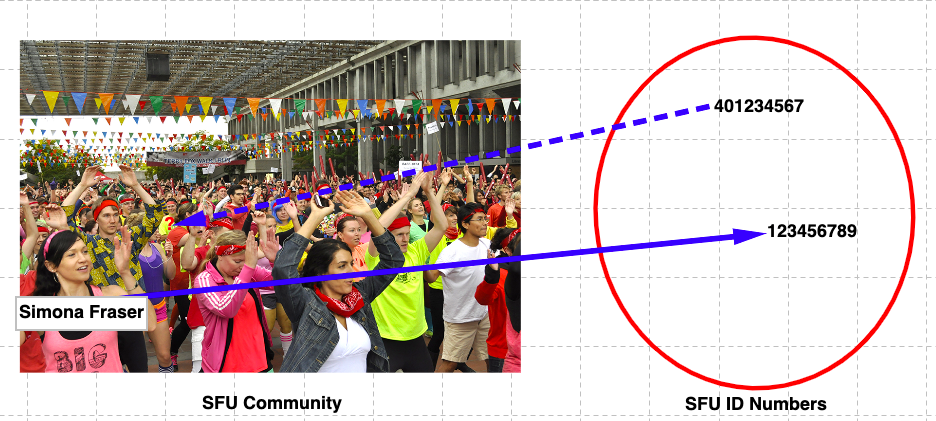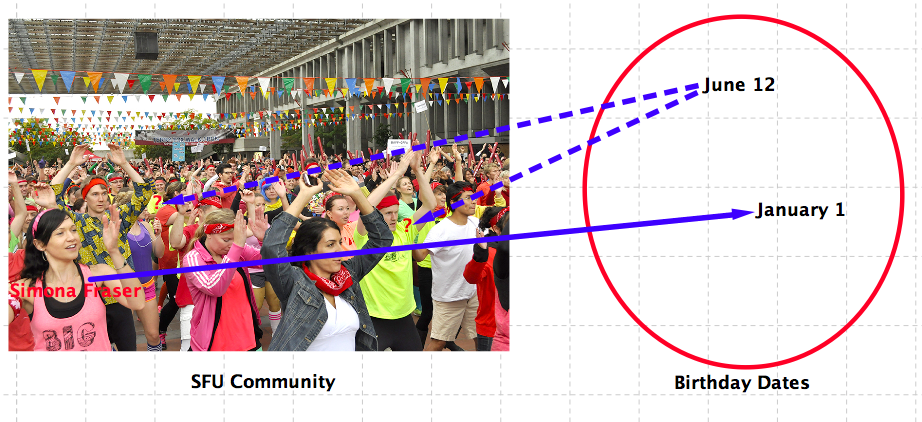Section 1.6 Inverse Functions
Just as we have two eyes and two feet, duality is part of life. — Carlos Santana, a Mexican and American musician, 1947 –
Problem: Let \(f(x)=3x+1\text{.}\) For a given \(y\in \mathbb{R}\text{,}\) find \(x\) such that \(f(x)=y\text{.}\)
Consider the following situation: Each student, faculty, and staff member at SFU is given a unique ID number. Who is the member of the SFU community with the ID number \(401234567\text{?}\)
See Figure 1.68.

Each member of the SFU community has a unique birthday date. Who is the member of the SFU community that was born on June 12?
See Figure 1.69.

Question: For which functions “going backwards” is again a function? See Figure 1.70 and Figure 1.71.
One–to–one functions: We say that a function \(f\) is one–to–one if different inputs have different outputs. In other words, \(f\) is one–to–one if
See Figure 1.72 and Figure 1.73.
Example 1.6.1. Two functions.
Determine if the given function is one–to–one or not one–to–one:
SFU ID Number Function?
Birthday Date Function?
The SFU ID Number Function is a one–to–one function because every member of the SFU community is associate with a different SFU ID number. (There are no two different people with the same ID number.)
The Birthday Date Function is not a one–to–one. There are at least two SFU students with the same birthday. (Why?)
Example 1.6.2. Two graphs.
Determine if the given function is one–to–one or not one–to–one. See Figure 1.56 and Figure 1.57.
Observe that
In other words, the function \(g\) is with the property that there are two different inputs, \(x_1=-2\) and \(x_2=2\text{,}\) with the same output, \(g(-2)=g(2)=4\text{.}\) Hence, by definition, the function \(g\) is not one–to–one.
Observe that the line \(y=4\) intersects the graph of the function \(g\) at two points, \((-2,4)\) and \((2,4)\text{.}\)
To establish if the function \(f\) is one–to–one or not one–to–one we demonstrate a more general approach.
Let \(x_1,x_2\in \mathbb{R}\) be such that \(f(x_1)=f(x_2)\text{.}\) Then
Hence, we have proved that the function \(f\) is with the property that there are no two different inputs with the same output. By definition, \(f\) is one–to–one.
Observe that any horizontal line \(y=a\) intersects the graph of the function \(f\) at exactly one point.
Horizontal line test: A graph represents a one-to-one function if and only if every horizontal line intersects that graph at most once.
Example 1.6.3. Horizontal line test.
Use the horizontal line test to determine if the graph represents an one–to–one function. See Figure 1.76, Figure 1.77, and Figure 1.78.
See Figure 1.79, Figure 1.80, and Figure 1.81.
Inverse function: Let \(f:A\to B\) be a one–to–one function. The inverse function of \(f\), denoted \(f^{-1}\text{,}\) is the function defined on the domain \(B\) by:
For any \(x\) in \(A\) and \(y\) in \(B\text{,}\) if \(f(x)=y\) then \(f^{-1}(y)=x\text{.}\)
See Figure 1.82 and Figure 1.83.
Note: \(f(x)=y\) and \(f^{-1}(y)=x\text{.}\)
Example 1.6.4. Inverse of SFU's ID function.
Let \(f\) be the “SFU ID Number” function: if “You” is a member of the SFU community then
Does \(f^{-1}\) exist and if it does what is \(f^{-1}(\text{Dr. J's SFU ID Number})\text{?}\)
Recall that \(f\) is one–to–one.
Since the “SFU ID Function” is a one–to–one function, its inverse, the function \(f^{-1}\text{,}\) exists and \(f^{-1}(\text{Dr. J's SFU ID Number})=\text{ Dr. J}\text{.}\)
Example 1.6.5. Inverse function.
Let \(f(x)=3x+1\text{.}\)
Find the real number \(x\) for which \(f(x)=8\text{.}\)
For a given \(y\in \mathbb{R}\) find \(x\) such that \(f(x)=y\text{.}\)
The equation \(f(x)=8\) is equivalent to the equation \(3x+1=8\text{.}\) Thus \(\displaystyle x=\frac{7}{3}\text{.}\)
-
We solve the equation \(3x+1=y\) for \(x\text{.}\) (Since the number \(y\) is “given,” we treat \(x\) as the unknown.)
From
\begin{equation*} 3x+1=y\Leftrightarrow 3x=y-1\Leftrightarrow x=\frac{y-1}{3} \end{equation*}we conclude that, for the given \(y\in\mathbb{R}\text{,}\)
\begin{equation*} f\left(\frac{y-1}{3}\right)= y. \end{equation*}This means that the INVERSE function is given by
\begin{equation*} f^{-1}(y)=\frac{y-1}{3}. \end{equation*}Since the letter that we use to annotate the independent variable does not matter we will also write
\begin{equation*} f^{-1}(x)=\frac{x-1}{3}. \end{equation*}
Four important facts: Let \(f\) be a one–to–one function and let \(f^{-1}\) be its inverse function. Then:
-
For any \(x\) in the domain of \(f\text{:}\) \((f^{-1}\circ f)(x)= f^{-1}(f(x))=x\text{.}\)
Example 1.6.6. Fact one.
Check this fact for the function \(f(x)=3x+1\text{.}\)
SolutionRecall that \(\displaystyle f^{-1}(x)=\frac{x-1}{3}\text{.}\) It follows that for all \(x\in \mathbb{R}\text{,}\)
\begin{equation*} (f^{-1}\circ f)(x)= f^{-1}(f(x))=f^{-1}(3x+1)=\frac{(3x+1)-1}{3}=\frac{3x+1-1}{3}=\frac{3x}{3}=x. \end{equation*} -
For any \(x\) in the range of \(f\text{:}\) \((f\circ f^{-1})(x)= f(f^{-1}(x))=x\text{.}\)
Example 1.6.7. Fact two.
Check this fact for the function \(f(x)=3x+1\text{.}\)
SolutionRecall that \(\displaystyle f^{-1}(x)=\frac{x-1}{3}\text{.}\) It follows that for all \(x\in \mathbb{R}\text{,}\)
\begin{equation*} (f\circ f^{-1})(x)= f(f^{-1}(x))=f\left(\frac{x-1}{3}\right)=3\cdot \frac{x-1}{3}+1=(x-1)+1=x. \end{equation*} -
\(\displaystyle (f^{-1})^{-1}=f\)
Example 1.6.8. Fact three.
Check this fact for the function \(f(x)=3x+1\text{.}\)
SolutionRecall that \(\displaystyle f^{-1}(x)=\frac{x-1}{3}\) is a one–to–one function. This means that its inverse function \((f^{-1})^{-1}\) exists. Recall that by definition of the inverse function,
\begin{equation*} (f^{-1})^{-1}(x)=y \Leftrightarrow x=f^{-1}(y). \end{equation*}In other words, for a given real number \(x\) we need to solve the equation \(f^{-1}(y)=x\) in terms of the unknown \(y\text{.}\) Hence
\begin{equation*} \frac{y-1}{3}=x\Leftrightarrow y-1=3x \Leftrightarrow y=3x+1=f(x) \end{equation*}which implies that \((f^{-1})^{-1}(x)=f(x)\) for all real numbers \(x\text{.}\)
-
If the point \((x,y)\) belongs to the graph of \(f\) then the point \((y,x)\) belongs to the graph of the function \(f^{-1}\text{.}\) In other words, graphs of \(f\) and \(f^{-1}\) are symmetric with respect to the line \(y=x\text{.}\)
Example 1.6.9. Fact four.
Check this fact for the function \(f(x)=3x+1\text{.}\)
SolutionSee Figure 1.84.
Figure 1.84. Graphs of \(f\) and \(f^{-1}\) are symmetric with respect to the line \(y = x\)
About to meet an old friend: Consider Figure 1.85
Note that the graph of the function \(g(x)=x^2\text{,}\) \(x\geq 0\text{,}\) passes the horizontal line test. Hence the “green” graph represents a one–to–one function. It follows that the function \(g\) has an inverse function.
An old friend: What is the inverse function of the function \(g(x)=x^2\text{,}\) \(x\geq 0\text{?}\) See Figure 1.86 and Figure 1.87.
Example 1.6.10. The square root function.
Let \(f(x)=x^2\text{,}\) \(x\in \mathbb{R}\text{,}\) \(g(x)=x^2\text{,}\) \(x\geq 0\text{,}\) and \(g^{-1}(x)=\sqrt{x}\text{.}\) Investigate the following functions:
\(\displaystyle g\circ g^{-1}\)
\(\displaystyle f\circ g^{-1}\)
\(\displaystyle g^{-1}\circ g\)
\(\displaystyle g^{-1}\circ f\)
-
For \(x\geq 0\text{,}\)
\begin{equation*} (g\circ g^{-1})(x)=g(g^{-1}(x))=g(\sqrt{x})=(\sqrt{x})^2=x. \end{equation*} -
For \(x\geq 0\text{,}\)
\begin{equation*} (f\circ g^{-1})(x)=f(g^{-1}(x))=f(\sqrt{x})=(\sqrt{x})^2=x. \end{equation*} -
For \(x\geq 0\text{,}\)
\begin{equation*} (g^{-1}\circ g)(x)=g^{-1}(g(x))=g^{-1}(x^2)=\sqrt{x^2}=x. \end{equation*} -
For \(x\in \mathbb{R}\text{,}\)
\begin{equation*} (g^{-1}\circ f)(x)=g^{-1}(f(x))=g^{-1}(x^2)=\sqrt{x^2}=|x|. \end{equation*}
Two important examples and a fact that you have to know:
Example 1.6.11. The identity function.
Let \(f(x)=x\text{.}\) Check that \(f\) is one–to–one and find its inverse function \(f^{-1}\text{.}\) See Figure 1.88.
Observe that the graph of the function \(f(x)=x\) passes the horizontal line test.
Looking at the graph of the the function \(f\) we note that it coincides with the line \(y=x\) and thus it is symmetric to itself with the respect to the line \(y=x\text{.}\) Hence \(f^{-1}(x)=x\text{.}\)
Example 1.6.12. The reciprocal function.
Let \(g(x)=\frac{1}{x}\text{,}\) \(x\not=0\text{.}\) Check that \(g\) is one–to–one and find its inverse function \(g^{-1}\text{.}\) See Figure 1.89.
Observe that the graph of the function \(g(x)=\frac{1}{x}\text{,}\) \(x\not= 0\text{,}\) passes the horizontal line test.
Looking at the graph of the the function \(f\) we note that it coincides with the line \(y=x\) and thus it is symmetric to itself with the respect to the line \(y=x\text{.}\) Hence \(g^{-1}(x)=\frac{1}{x}\text{,}\) \(x\not= 0\text{.}\)
DO NOT CONFUSE \(f^{-1}(x)\) AND \(\displaystyle \frac{1}{f(x)}\text{!}\) Those are two different mathematical objects.
Example 1.6.13. Finding the inverse.
Let \(\displaystyle f(x)=\frac{x+2}{x+1}\text{.}\)
Find the domain of \(f\text{.}\)
Sketch the graph of the function \(f\text{.}\)
Check that the function \(f\) is one–to–one.
Find \(f^{-1}\text{.}\)
-
Since the function \(f\) is a rational function its domain is given by
\begin{equation*} \{x\in \mathbb{R}:x+1\not= 0\}=\{x\in \mathbb{R}:x\not= -1\}=\mathbb{R}\backslash \{-1\}. \end{equation*} -
Note that \(\displaystyle f(x)=\frac{x+2}{x+1}=\frac{1+(x+1)}{x+1}=\frac{1}{x+1}+1\text{.}\)
See Figure 1.90.
Figure 1.90. A graph of the function\(f(x)=\frac{x+2}{x+1}=\frac{1}{x+1}+1\) in three steps Note that the graph of the function \(f\) passes the horizontal line test.
Step 1: Write \(y=\frac{x+2}{x+1}.\)
-
Step 2: Interchange the roles of “\(x\)” and “\(y\)”
\begin{equation*} x=\frac{y+2}{y+1} \end{equation*}and solve for \(y\text{:}\)
\begin{equation*} x=\frac{y+2}{y+1}\Leftrightarrow x(y+1)=y+2\Leftrightarrow xy+1=y+2\Leftrightarrow xy-y=2-x \end{equation*}\begin{equation*} \Leftrightarrow (x-1)y=2-x\Leftrightarrow y=\frac{2-x}{x-1}. \end{equation*} -
Step 3: The inverse function is
\begin{equation*} f^{-1}(x)=\frac{2-x}{x-1} \end{equation*}with the domain \(\{x\in \mathbb{R}: x-1\not=0\}=\{x\in \mathbb{R}: x\not=1\}\text{.}\)
Increasing and decreasing functions:
-
A function \(f\) is strictly increasing on the interval \(I\) if for any \(a,b\in I\)
\begin{equation*} a\lt b \Rightarrow f(a)\lt f(b). \end{equation*} -
A function \(f\) is strictly decreasing on the interval \(I\) if for any \(a,b\in I\)
\begin{equation*} a\lt b \Rightarrow f(a)>f(b). \end{equation*}
See Figure 1.91.
Fact: If a function \(f\) is strictly increasing (or strictly decreasing) on its domain then \(f\) is a one–to–one function.
Example 1.6.14. Up and down.
A taste of calculus: Determine the intervals where the function
is strictly increasing and where it is strictly decreasing. See Figure 1.92.
Observe from the graph that the function is increasing on the intervals \((-2,-1)\) and \((1,2)\) and decreasing on the interval \((-1,1)\text{.}\)
